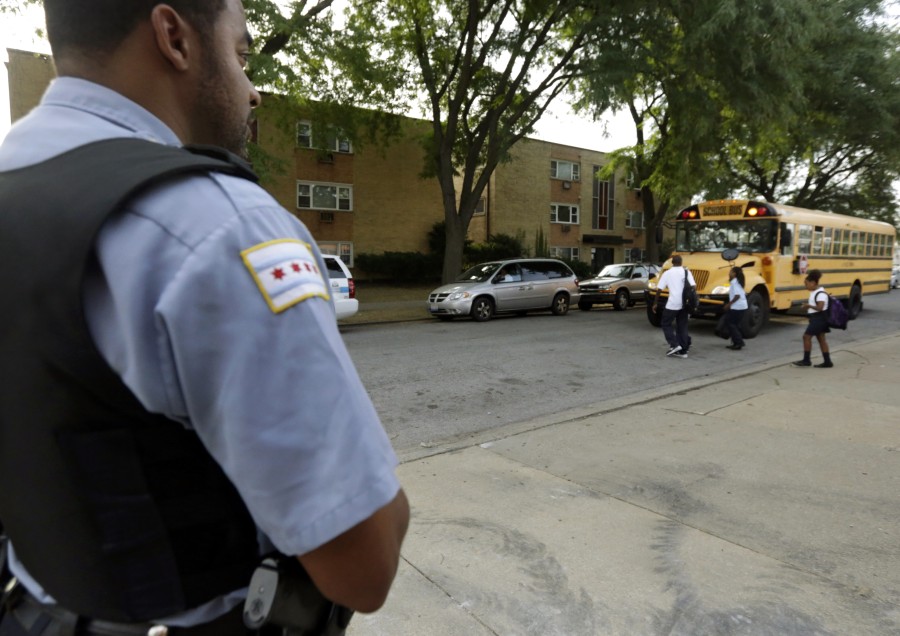Chicago Police To Continue Sending 2 Officers To Schools That Voted To Have Just 1
Chicago Public Schools says the Police Department decided to temporarily send the two officers to the schools, citing safety issues. It’s unclear when they’ll leave.
By Sarah Karp

Chicago Police To Continue Sending 2 Officers To Schools That Voted To Have Just 1
Chicago Public Schools says the Police Department decided to temporarily send the two officers to the schools, citing safety issues. It’s unclear when they’ll leave.
By Sarah KarpAmid calls to remove police from schools and stop the school-to-prison pipeline, 23 elected Local School Councils in Chicago public schools took a step in that direction this summer by voting to remove one of two officers.
But the Police Department and the school district are now rejecting that directive. Chicago Public Schools says the Police Department will continue to send two officers to each of these schools when classes begin on Monday. School district officials said they will “ensure” the second officer is temporary, but they did not say how long that extra officer would remain in place.
In a letter to council members, Chicago Public Schools cited “concerns raised by CPD to ensure the safety of schools and their school community” coming out of the pandemic. Separately, CPS also said two officers would support the transition back to in-person learning.
Neither Chicago Public Schools nor the Police Department would provide additional information explaining these concerns.
Most of the high schools that voted to remove one officer are in low-income Black neighborhoods, while those that voted to remove both officers have mostly Latino students or a mixed student body.
“It is bull,” said Dexter Leggin, a parent who works with the advocacy group Community Organizing and Family Issues (COFI). “I think that the police in the Black and brown communities bully their way through things to make people do what they want to do and they are bullying Chicago Public Schools to do what they want to do.”
Leggin’s son attends Al Raby High School in West Garfield Park. The council voted to keep one of two officers.
Two years ago, CPS started letting LSCs decide whether to station police in their schools. Of the 77 high schools with police at the time, so far 33 voted to remove both officers, 21 voted to keep two and 23 voted to keep one. This is the first year schools had the option to remove only one officer.
The school district says the Police Department will not charge the schools for the additional police officer. But officials also say they have yet to reach an agreement with the police and will continue to operate under last year’s agreement.
That one-year contract called for CPS to pay the police $12.1 million.
Advocacy groups, including COFI, are calling on the police to “respect the extensive community engagement process that took place over the past year,” according to a statement released on Monday.
Angelo McFarland, who graduated from Austin High School last year, said he suspects that the police want two officers in schools because they are worried about officers being alone. He said he thinks that is wrongheaded.
“It is just children in the school and they have all this armor to help them out,” said McFarland, who works with the student advocacy group called VOYCE. He said he doesn’t think police in schools are “necessary” at all.
Before voting on whether to keep police, schools had to come up with alternative safety plans for Local School Councils to consider. CPS offered to fund those alternative plans and the advocacy groups say this year 31 schools will get more than $3 million to implement those plans. Schools are using that money to pay for things like a dean of culture and climate or a restorative justice coordinator.
Jadine Chou, chief of safety and security for CPS, said CPS believes it is “absolutely critical” to honor “this past year’s process,” which included the LSC votes and the development of the alternative safety plans. She said the school district is committed to working with parents, teachers, LSCs, parents and students “on what it means to them to have safety in schools in order to help inform our next steps.”
Sarah Karp covers education for WBEZ. Follow her on Twitter @WBEZeducation and @sskedreporter.
